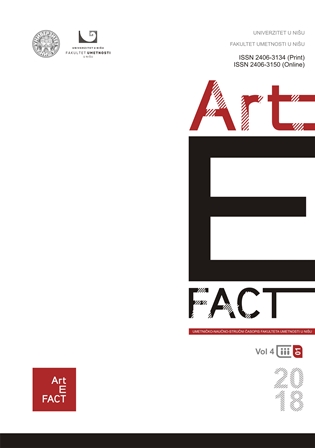Contemporary approaches in Russian instructive literature for initial teaching of solfeggio
Abstract
The Russian instructional literature for the initial teaching of solfeggio, brings a turning point in relation to the presentation of teaching material in the literature of the 20th century, where the main goal ‒ the development of musical hearing was achieved through auditory analysis and music dictation. Studies have shown that in the 21st century pupils there is a decrease in psychophysical activities, a decline in motivation and a lack of interest. That's exactly what influenced most Russian authors to opt for a different concept of content exposure, where the primary place was played by a music game in three basic sights: play-story, play-role and competition. Significant place was given to didactic illustrations that contribute to the memory and understanding of concepts from music theory. A new approach is also seen in the presence of the story of music, which is the starting point for the creation of an associative music base. In them, the connection of content is realized through various forms of work (melodic, improvisation, piano accompaniment). Standard areas of teaching solfeggio, such as music dictation, rhythm and music theory, are still present in the manuals, but the transformation has been made in the realization and organization of teaching material. The methodological approach of the Russian authors, the concept based on the principle of "lesson-play", the presentation of teaching materials based on colorful ideas, enabled the preservation of the continuity of traditional solfeggio teaching and made the manuals more attractive and more acceptable to modern generations.
References
Абелян, Л. (1982). Забавное сольфеджио. Москва: Советскый композитор.
Берак, О., & Карасева, М. (2009). Как преподавать сольфеджио в XXI веке. Москва: Классика – XXI.
Евтихиев, П. (2002). Музыкальная реабилитология и современные проблемы музыкального образования. У Музыкальное образование: сегодня и завтра. Москва.
Ефремова, Л. (2006). Учится интересно. Санкт-Петербург: Композитор.
Камаева, Т., & Камаев, А. (2004). Азартное солЬфеджио (Методическое пособие). Москва: Владос.
Камозина, О. П. (2009). Неправильное сольфеджио, в котором вместо правил – песенки, картинки и разные истории. Ростов на Дону: Феникс.
Тигранов, Г. Г. (1987). Ленинградская консерватория в воспоминаниях. Ленинград: Музыка.
Artefact omogućava otvoreni pristup i, u skladu sa preporukom CEON-a, primenjuje Creative Commons (CC BY) odredbe o autorskim pravima:
Autori koji objavlјuju u Artefact-u pristaju na sledeće uslove:
a) Autori zadržavaju autorska prava i pružaju časopisu pravo prvog objavlјivanja rada i licenciraju ga Creative Commons licencom koja omogućava drugima da dele rad uz uslov navođenja autorstva i izvornog objavlјivanja u ovom časopisu.
b) Autori mogu izraditi zasebne, ugovorne aranžmane za neekskluzivnu distribuciju rada objavlјenog u časopisu (npr. postavlјanje u institucionalni repozitorijum ili objavlјivanje u knjizi), uz navođenje da je rad izvorno objavlјen u ovom časopisu.
c) Autorima je dozvolјeno i podstiču se da postave objavlјeni rad onlajn (npr. u institucionalnom repozitorijumu ili na svojim internet stranicama) pre i tokom postupka prijave priloga, s obzirom da takav postupak može voditi produktivnoj razmeni ideja i ranijoj i većoj citiranosti objavlјenog rada (up. Efekat otvorenog pristupa).

